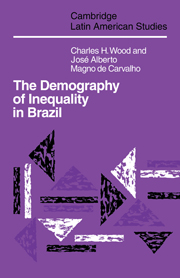Book contents
- Frontmatter
- Contents
- Illustrations
- List of tables
- Preface
- 1 Introduction
- 2 Framework for the study of population, development and inequality
- 3 Growth and distribution in historical perspective
- 4 Income inequality and length of life
- 5 Wage policy, infant mortality and collective social action in São Paulo
- 6 Racial inequality and child mortality
- 7 The “baby bust”
- 8 Income distribution and population growth
- 9 Agrarian structure and the rural exodus
- 10 Colonization and frontier expansion in Amazônia
- 11 Development and persistent underemployment
- 12 The demography of inequality in Brazil: summary and conclusion
- Appendix: A note on method
- Notes
- Bibliography
- Index
- CAMBRIDGE LATIN AMERICAN STUDIES
5 - Wage policy, infant mortality and collective social action in São Paulo
Published online by Cambridge University Press: 04 August 2010
- Frontmatter
- Contents
- Illustrations
- List of tables
- Preface
- 1 Introduction
- 2 Framework for the study of population, development and inequality
- 3 Growth and distribution in historical perspective
- 4 Income inequality and length of life
- 5 Wage policy, infant mortality and collective social action in São Paulo
- 6 Racial inequality and child mortality
- 7 The “baby bust”
- 8 Income distribution and population growth
- 9 Agrarian structure and the rural exodus
- 10 Colonization and frontier expansion in Amazônia
- 11 Development and persistent underemployment
- 12 The demography of inequality in Brazil: summary and conclusion
- Appendix: A note on method
- Notes
- Bibliography
- Index
- CAMBRIDGE LATIN AMERICAN STUDIES
Summary
The military coup in 1964 marked a new era of economic planning in Brazil. In an effort to contain inflation and attract foreign investment, the regime forged a development strategy that included, as a central component, a wage containment policy. The power of labor unions to act as effective bargaining units, already undermined by the corporatist legacy of the Vargas period, was further curtailed by legislative fiat, political repression and the occasional use of force. To achieve the labor peace required of a sound “investment climate,” the direct negotiation between capital and labor was replaced by a bureaucratic method to establish salary levels. The procedure was putatively intended to adjust the minimum wage so as to recover income eroded by inflation. In practice the components of the formula designed to adjust for inflation were deliberately understated during certain periods. From 1964 to about 1975 the real value of the minimum wage deteriorated. In the latter half of the decade, a time of widespread labor unrest, the downward trend was reversed and the minimum salary gained in purchasing power.
Intervention in factor markets to promote development is a popular theme in neoclassical economics. Proponents of wage containment policy point to market distortions that understate the relative price of capital and overstate labor costs.
- Type
- Chapter
- Information
- The Demography of Inequality in Brazil , pp. 104 - 134Publisher: Cambridge University PressPrint publication year: 1988
- 1
- Cited by



